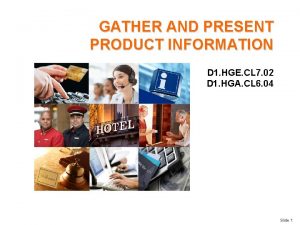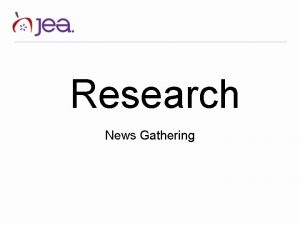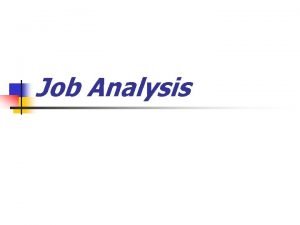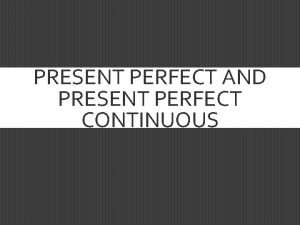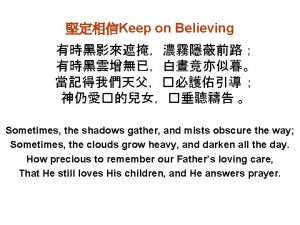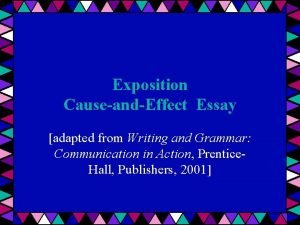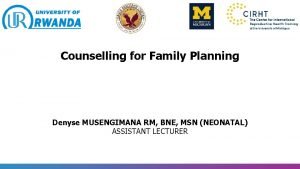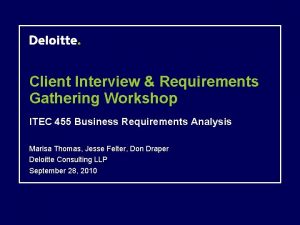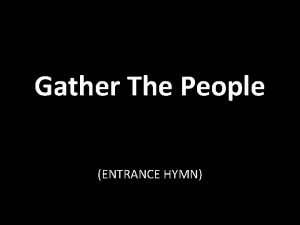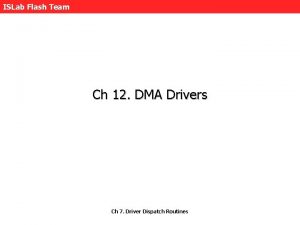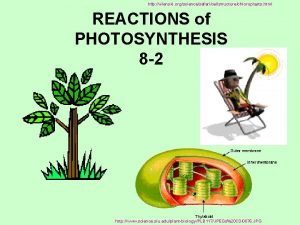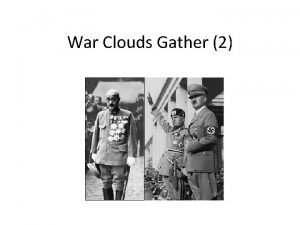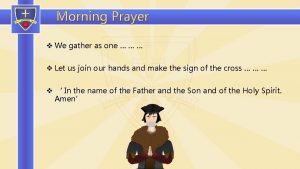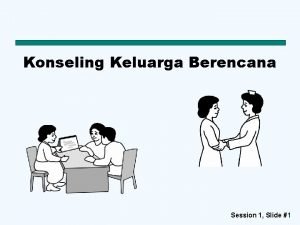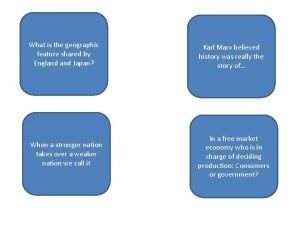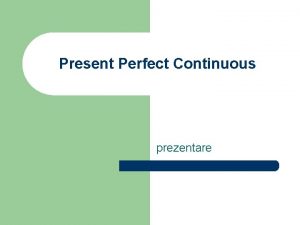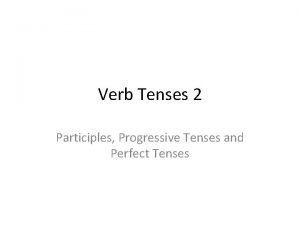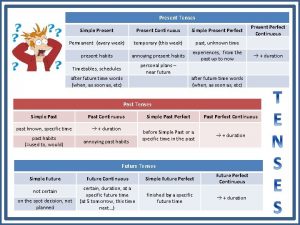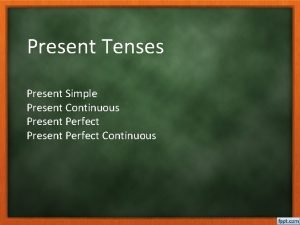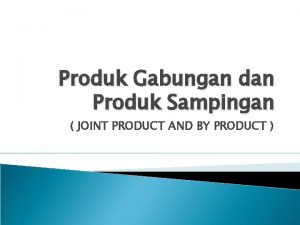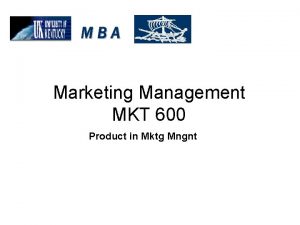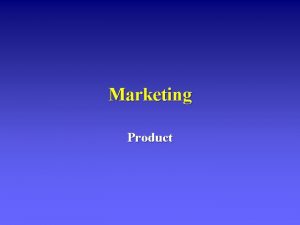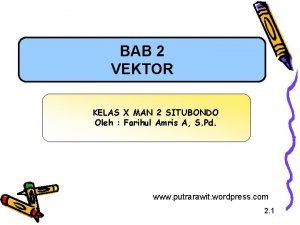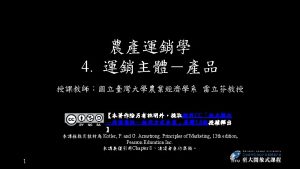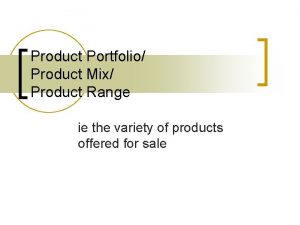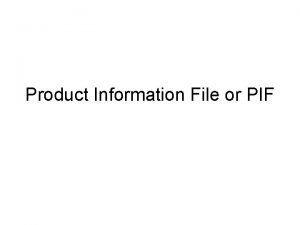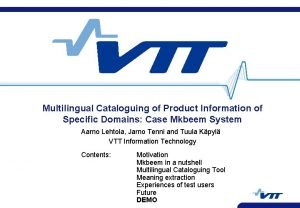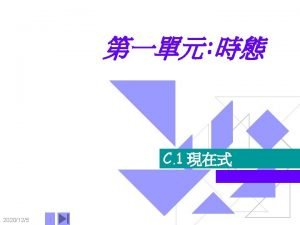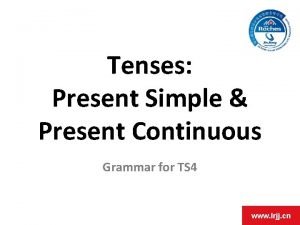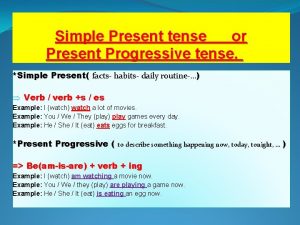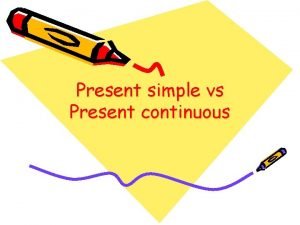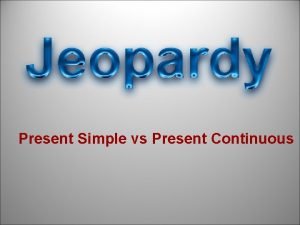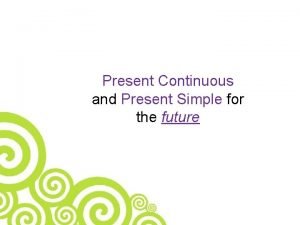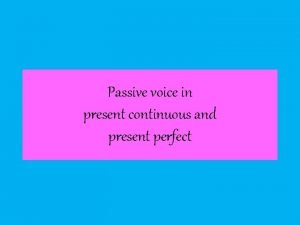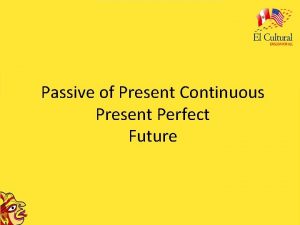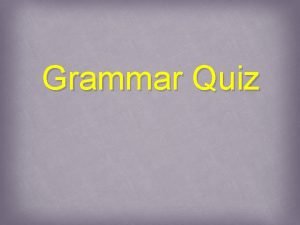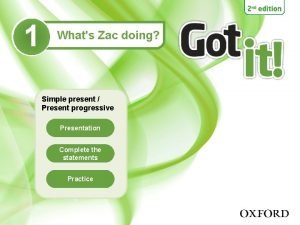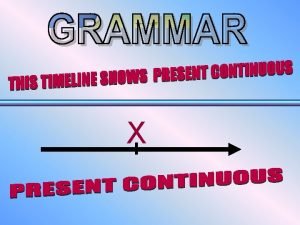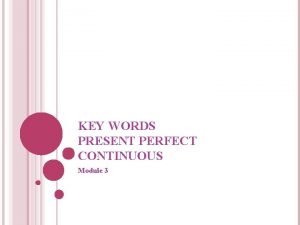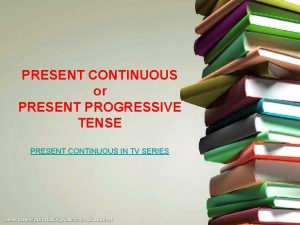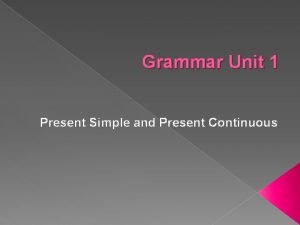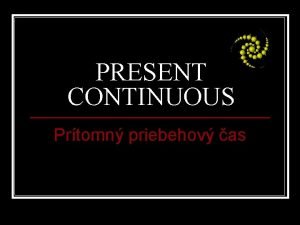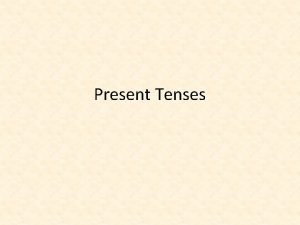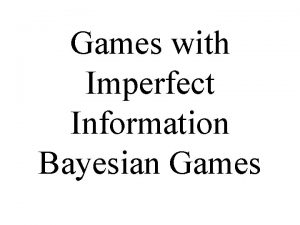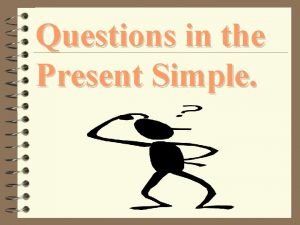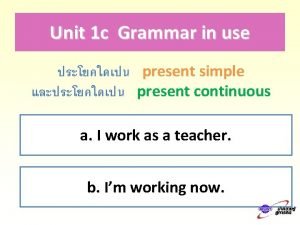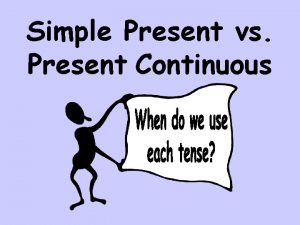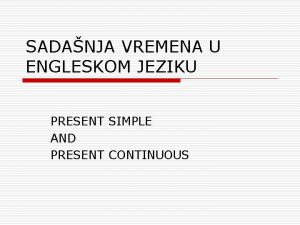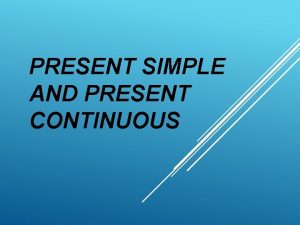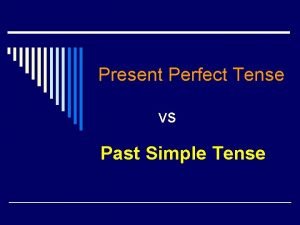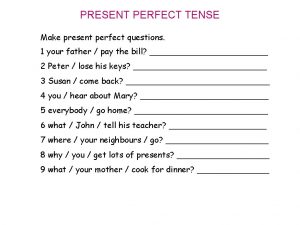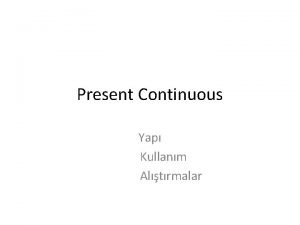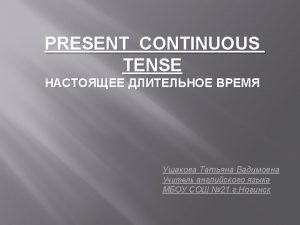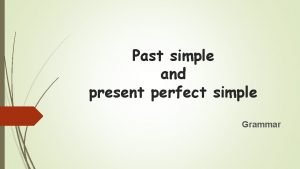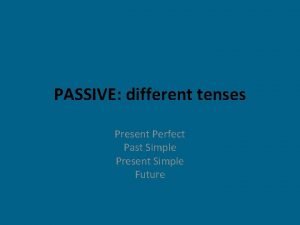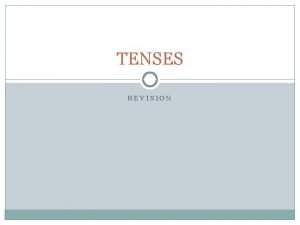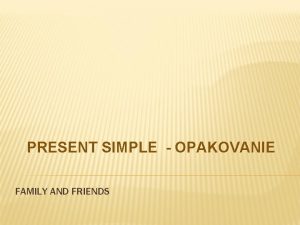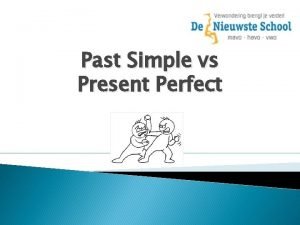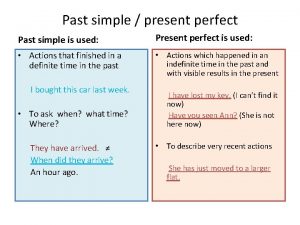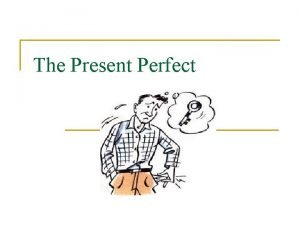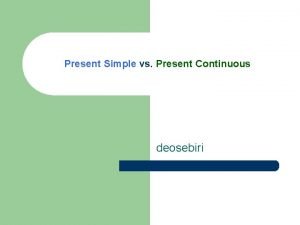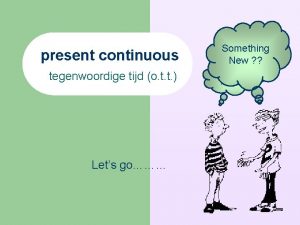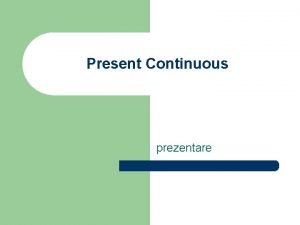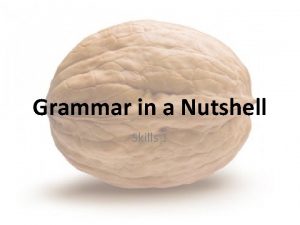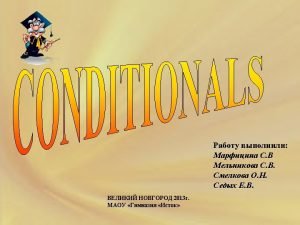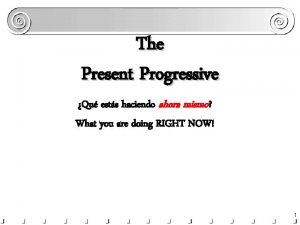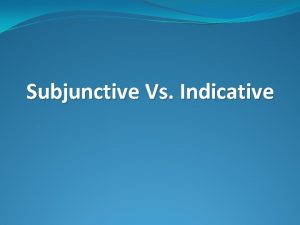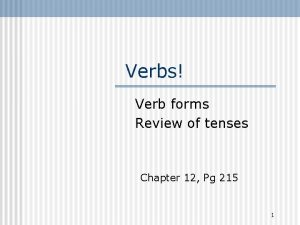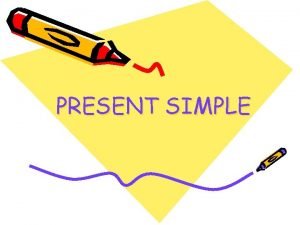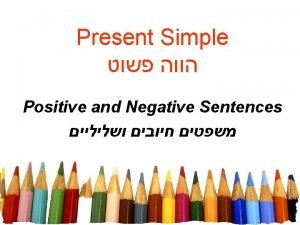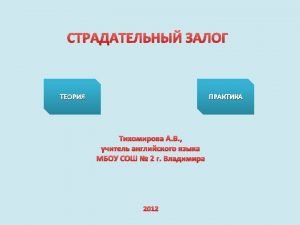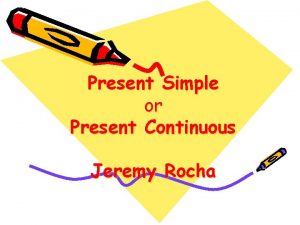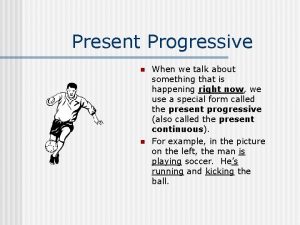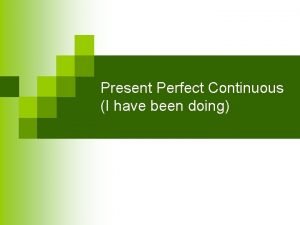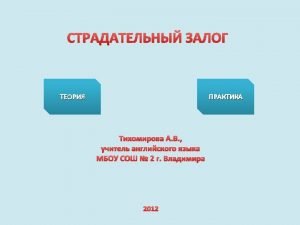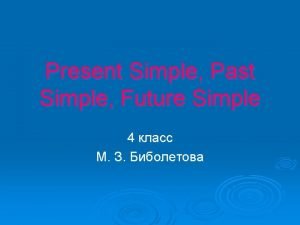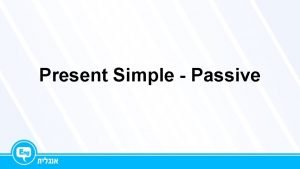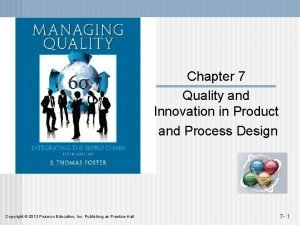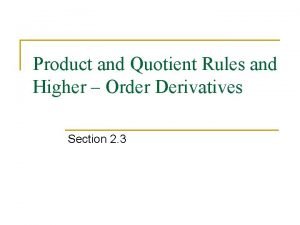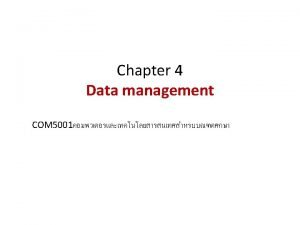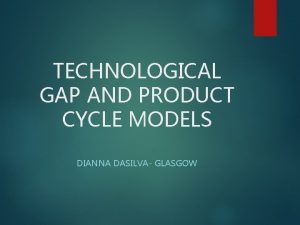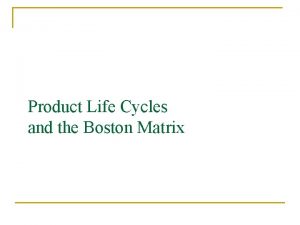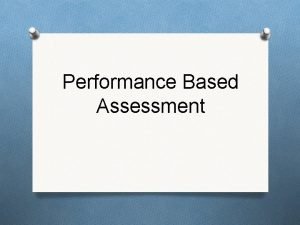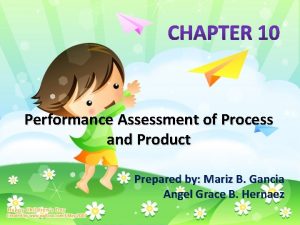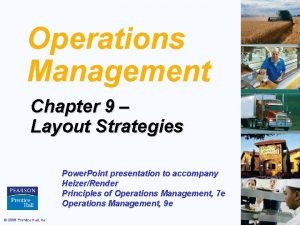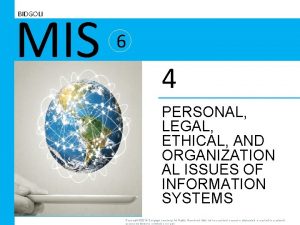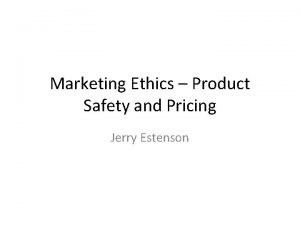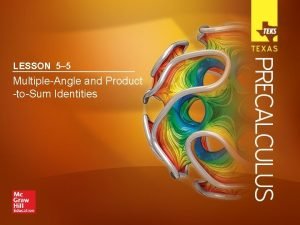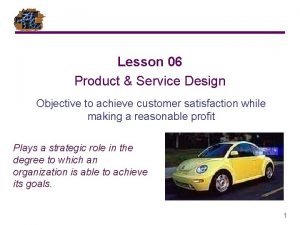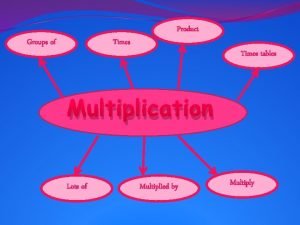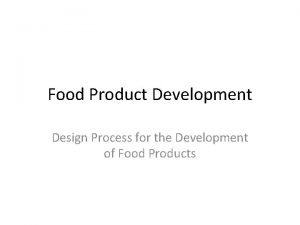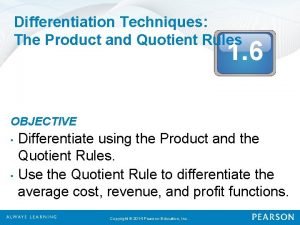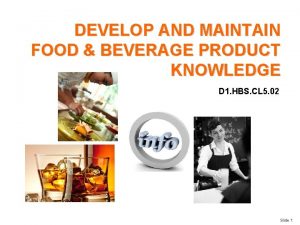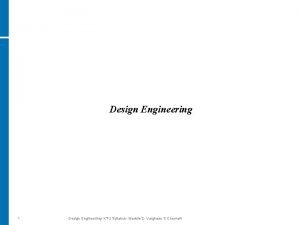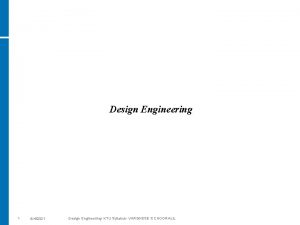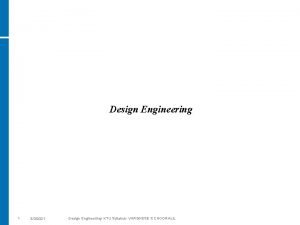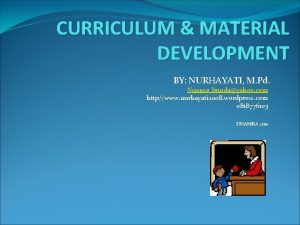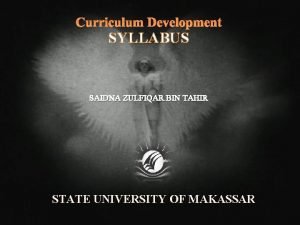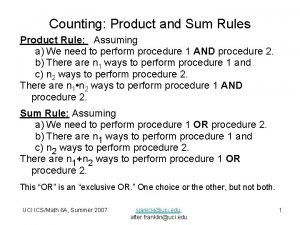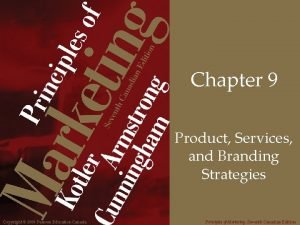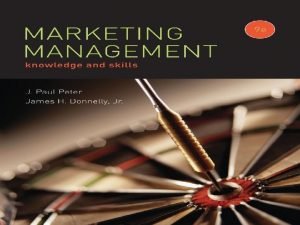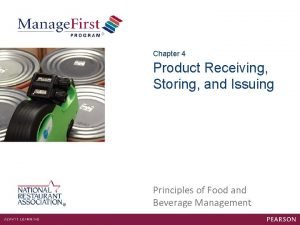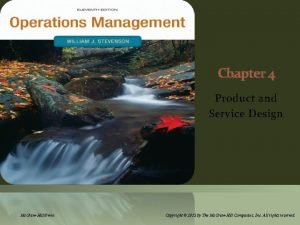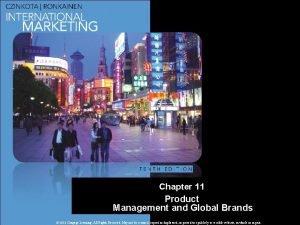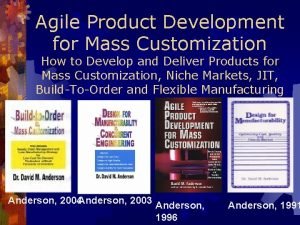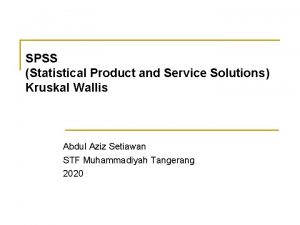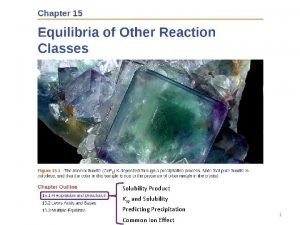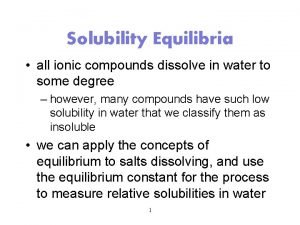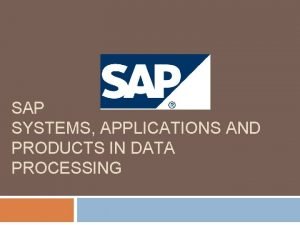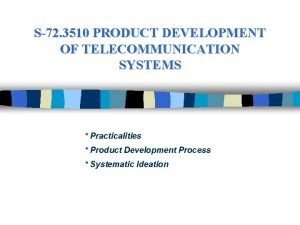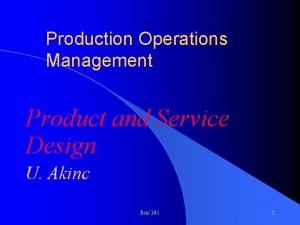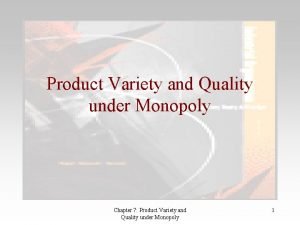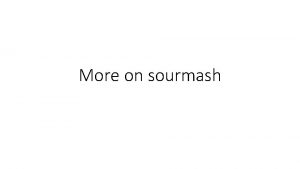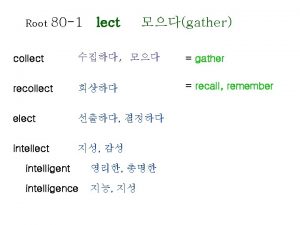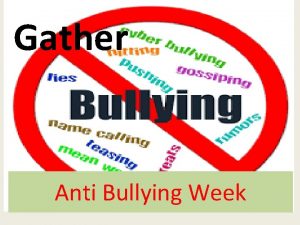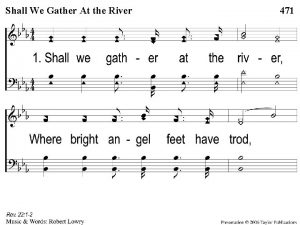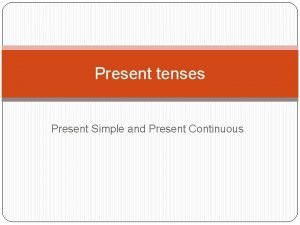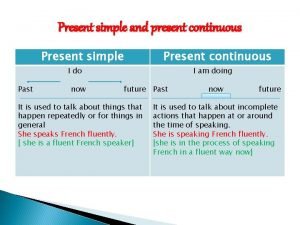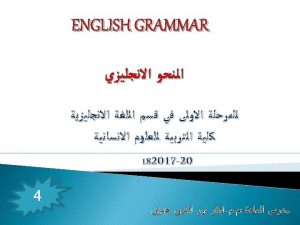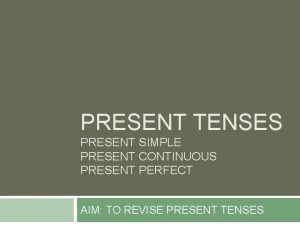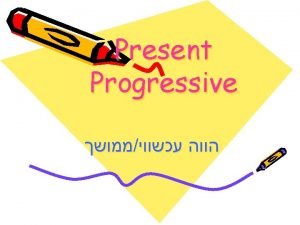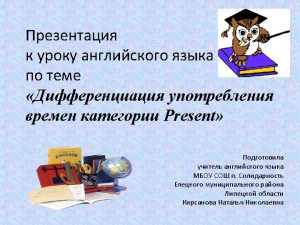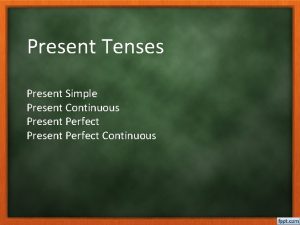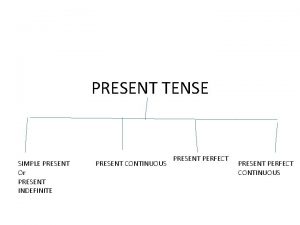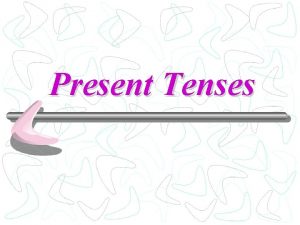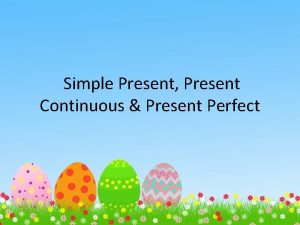GATHER AND PRESENT PRODUCT INFORMATION D 1 HGE


















































































































































































- Slides: 178

GATHER AND PRESENT PRODUCT INFORMATION D 1. HGE. CL 7. 02 D 1. HGA. CL 6. 04 Slide 1

Subject Elements This unit comprises three Elements: � Gather and organise information � Research and analyse information � Present information Slide 2

Assessment for this unit may include: � Oral questions � Written questions � Work projects � Workplace observation of practical skills � Practical exercises � Formal report from supervisor Slide 3

Element 1 Gather and organise information Slide 4

Gather and organise information Performance Criteria for this Element are: � Gather and organise information in a format suitable for analysis, interpretation and dissemination in accordance with organisational requirements and relevant legislation codes and standards � Access and assess information held by the organisation for accuracy and relevance in line with established organisational requirements Slide 5

Gather and organise information Performance Criteria for this Element are: � Ensure methods of collecting information are reliable and make efficient use of resources in accordance with organisational requirements � Use business technology to access, organise and monitor information in accordance with organisational requirements � Update, modify, maintain and store information in accordance with organisational requirements Slide 6

Importance of information The hospitality and tourism industry is one of the largest industries in the world and for many countries is its major economy and employer. Industry knowledge is a vital pre-requisite for effective performance within the industry. Slide 7

Importance of information For all businesses within the hospitality and tourism industry, it is important to have up-to-date information so you can: � Talk to customers about industry-specific events, trends and happenings � Plan your career as opportunities present themselves � Know when you need to update your training � Cultivate and maintain a professional interest in what is truly a profession Slide 8

Importance of information � Communicate effectively with colleagues and management who have themselves kept up-to-date � Learn new techniques � Develop a broader appreciation of what the industry is all about � Understand who the key players are, and how they operate Slide 9

Types of industry information Main categories of information The two main categories of information that all staff should know relate to: � The Tourism and Hospitality Industry � Their specific role Slide 10

Tourism and Hospitality industry sectors Accommodation This sector includes but is not limited to: � Hotels and motels � Guest houses and bed and breakfasts � Caravan parks and camping grounds � Resorts and time share properties � Apartments, villas and cottages � Conference and exhibition centres Slide 11

Tourism and Hospitality industry sectors Attractions and theme parks This sector includes but not limited to: � Museums and galleries � National parks, wildlife parks and gardens � Theme parks � Heritage sites and centres � Sports activity centres � Aquariums and zoos Slide 12

Tourism and Hospitality industry sectors Tour operators � A tour operator typically organises sightseeing tours and accommodation in a particular destination or region Inbound tour wholesaler � An inbound tour wholesaler packages products to form a trip for an overseas market travelling to your country Slide 13

Tourism and Hospitality industry sectors Outbound tour wholesaler � An outbound tour wholesaler negotiates product from International Suppliers for clients in your country travelling to an international destination Retail travel agents � A retail travel agent is the go-between between the client and the wholesaler Slide 14

Tourism and Hospitality industry sectors Local, regional and national information services � These information services exist to assist the public and travel agents in obtaining knowledge and information on a particular region from the experts Meetings and events � These companies organise meetings, conferences and major events by booking flights, accommodation, tours and the meeting facilities Slide 15

Tourism and Hospitality industry sectors Corporate agents � This sector tenders for travel accounts from large, medium and small sized businesses Airlines � Airlines own the planes and sell seats to all sectors in the travel industry Slide 16

Information relating to job roles Not only is it important for all persons working in the industry to understand their industry and sector within it, but also to collect information that relates to their specific job roles. Slide 17

Information relating to job roles Career prospects This includes being able to have a clear understanding of: � Your development path within the industry � Your next career step including need for: § training § experience § qualifications Slide 18

Information relating to job roles Employment obligations and entitlements You can obtain information regarding your employment obligations and entitlements from a combination of: � The employment instrument you are employed under � The job description for your role � The job specification for your position � Talking to your employer about their expectations of your work Slide 19

Information relating to job roles Product Knowledge Product knowledge embodies knowledge about: � Products sold � Services provided � Facilities available � Operating procedures and conditions of the business Slide 20

Information relating to job roles ‘Quality assurance’ (QA) This is a term used to systematically measure and compare aspects of operations within a business against operational standards of performance. ‘Total Quality Management’ (TQM) This is a philosophy of management that is driven by customer needs and expectations to provide a process of excellence. Slide 21

Information relating to job roles Other job related information � Union and employer concerns � Legislative and political changes � Service, product and facility initiatives � What else is important to know in relation to your job role? Slide 22

Sources of information There a number of sources that will be a great starting point to get an overview of the industry as a whole: � Colleagues, supervisors and managers � Representatives � Developing your own industry network � Conferences and seminars � Product launches � Asking someone to be your mentor Slide 23

Sources of information Information services Most information services are fee-for-service providers. This means it costs money to use their services for: � E-newsletters � Fact Sheets � Updates � Guides � Information Sheets � Over-the-phone advice Slide 24

Sources of information Written materials � Trade magazines � Hotel school publications � Newsletters � Brochures � Advertisements � Reference books Slide 25

Sources of information Government and Industry bodies The ASEAN region, whilst working collectively to achieve a primary purpose of attracting tourism to the region as a whole, each participating government will also have their own websites and departments in which to collect information. Slide 26

Government and Industry bodies � A range of industry specific bodies have been established to cater to the needs of industry � What tourism industry bodies do you know of? Slide 27

Government and Industry bodies Their goal is to ensure the tourism industry: � Provides a safe and secure offering to its customers � Is regulated and operates in a legal and compliant manner � Provides quality products and services to its customers � Employs staff who have the necessary knowledge, skill relevant to the current industry needs and expectations Slide 28

Government and Industry bodies Ministries of Tourism The Ministry may co-ordinate special initiatives including: � Selecting and managing heritage sites � Dedication and allocation of government funding to tourism initiatives � Providing information on news laws and regulations � Establishing service excellence awards � Publishing and managing tenders for tourism projects Slide 29

Government and Industry bodies Tourism Boards The primary task of tourism boards is to coordinate the efforts of hotels, airlines and travel agents to develop the fledging tourism industry of the country. Industry Authorities are established, either by a government or working closely with government to provide services relating to the tourism industry. Slide 30

Government and Industry bodies Industry Associations These bodies provide businesses with a variety of services which can include: � Representing the industry � Legal advice � Training � Industry standards and benchmarks � Cost savings Slide 31

Government and Industry bodies Industry Unions In the same way that industry associations represent the interests of business, the unions represent the interests of employees. Slide 32

Obtaining information � The key to obtaining information is for you to be proactive. It is highly unlikely most information will seek you out, so you have to go and find it � Obtaining the information you need is a matter of applying yourself to the sources identified Slide 33

Obtaining information � Subscribing to, and reading, industry magazines, newsletters, updates � Picking and reading through the local and city newspapers � Getting on Internet e-mail lists � Receiving newsletters and updates � Joining your local union or industry association to receive regular material � Reading books on the industry sector that you are working in Slide 34

Obtaining information Getting out and having a look around to see: � What’s happening � What people are doing � What the competition is doing � What people are doing and saying Slide 35

Obtaining information Keys when gathering information: � Display a friendly attitude towards people � Use an appropriate tone of voice and volume � Ask clear and concise questions. Slide 36

Monitoring current issues It is important to note though, the collection of information is most powerful when used to gain an understanding of current issues that are important to the success of the operation: � What are current issues of importance? � Why are they important? � How can you monitor them? Slide 37

Monitoring current issues In order to keep up-to-date with industry issues impacting within your workplace: � Conduct constant internet research � Attend all meetings and discuss relevant issues � Monitor the media � Read about it in the journals and on-line subscriptions detailed in this manual � Talk to supervisors and management � Talk to customers Slide 38

Tourism industry statistics and trends Given the tourism and hospitality industry is one of the largest industries in the world, it is not surprising to learn that they are numerous sources devoted to industry news, trends and statistics. Slide 39

Types of industry statistics and trends Industry Statistics Industry statistics are popular amongst both employees within the tourism industry and also end consumers. Statistics prove a ‘snapshot’ of important information which can be examined and applied to: � Improve business operations � Attract new markets � Build confidence in the eyes of a consumer Slide 40

Types of industry statistics and trends Industry Statistics � Types of tourism businesses � Types and demographics of customers � Top destinations � Hotel occupancy percentages � Reasons for stays � Current industry information � Destination countries Slide 41

Types of industry statistics and trends Industry Statistics � Departure months � Length of stay � Type of organisation for the trip � Transport mode � Accommodation type � Expenditure � Popular tourist attractions Slide 42

Types of industry statistics and trends Industry Trends Understanding of current industry trends helps operators within the tourism and hospitality industry gain an understanding of what may take in the future. This helps to determine strategy and develop a competitive advantage over competitors. Slide 43

Types of industry statistics and trends Industry Trends � Great comparison-shopping by consumers � Tourism related applications ‘apps’ � Women-only floors � Budget lodging at private accommodation � Unusual one-off experiences and mini-vacations � App creators breaking through language barriers Slide 44

Types of industry statistics and trends Industry Trends � Websites offering personalized activities and tours � Using smart-phones as room keys � Booking agents to overlay the social graph, asking users to sign in with their social media accounts for the opportunity to hand-pick desirable seating arrangements � VIP treatment at amusement parks Slide 45

Operational Information � Most tourism and hospitality organisations will collect information on a daily basis, from a variety of sources � This information aims to provide managers with vital information relating to operations � It also helps staff in determining possible work demands or requirements Slide 46

Operational Information Some of this information may relate to: � Current operations � Projected operations � Past operational performance Slide 47

Operational Information The collection of information is helpful when: � Providing destination and specific product information and advice � Providing specific information and advice about the credentials of an operator � Selling products and services to the customer � Preparing quotations � Booking and coordinating a supplier service for the customer Slide 48

Operational Information The collection of information is helpful when: � Receiving and processing a reservation from a customer � Processing financial transactions � Issuing customer travel documentation � Issuing crew documentation or technical itineraries � Organising functions Slide 49

Operational Information The collection of information is helpful when: � Processing and monitoring meeting or event registrations � Purchasing promotional products � Hiring special equipment Slide 50

Operational Information Types of information Specific informational details in relation to products may include: � Costs, tariffs and rates � Additional taxes and levies imposed � Currency applied to the cost � Terms, conditions and rules � Scheduling information Slide 51

Operational Information Types of information � Product codes � Booking procedures � Point of departure � Route taken � Point of conclusion or disembarkation Slide 52

Operational Information Types of information � Touring inclusions and exclusions � Technical specifications for audiovisual and other meetings and events equipment � Specifications for products to be branded with corporate details Slide 53

Collecting Operational Information There a number of ways to collect information relating to operational effectiveness including: � Reports � Obtaining customer feedback � Using a pretend customer � Walking about the premises and observing � Use of checklists � Brainstorming sessions � Staff input and review Slide 54

Customer Information Understanding customers and their preferences is a very important aspect of a business. Therefore being able to collect information is very important to understand: � What your business is doing well to meet their needs � Identify where improvements can be made Slide 55

Customer Information Formal feedback � Customer comment cards � General Manager cocktail parties � Interviews and follow up calls � Meetings � Performance reviews Slide 56

Customer Information Informal feedback This information may come in the form of ‘gossip’ or ‘through the grapevine’, however is the provider of the largest amount of feedback. This includes: � General discussion � Observations Slide 57

Labour issues � Pay rates � The ability to recruit sufficient and properly trained or experienced staff � Working conditions � Training � Mandatory licensing and certification requirements � Superannuation and Insurance � Disciplinary and dismissal procedures Slide 58

Government initiatives � Creating advertising campaigns to promote certain locations or industry sectors � Funding training initiatives in certain trades or roles � Encouraging overseas workers � Amending or introducing legislation � Introducing changes to Industrial Relations legislation � Specific government initiatives Slide 59

Emerging markets � Spa resorts and the emergence of the well-being industry � Fast food � Recognition of ‘grey power’ and their potential for spending � Increase in the growth of ‘action’ holidays � Emphasis on domestic travel as opposed to internal travel Slide 60

Environmental and social concerns � Waste management, recycling of materials and a reduction in energy and resource consumption � Noise and air quality � Sustainable tourism activities � Respect for indigenous lands and cultures � Responsible advertising of hospitality products and services Slide 61

Environmental and social concerns � Complying with legislated service requirements (alcohol, gaming, tobacco) to minors � Social awareness towards alcohol and gaming problems � Ensure discrimination in the provision of hospitality services does not occur � Accommodating local concerns into the standard operating procedures � Changes or requirements to planning requirements Slide 62

Industry expansion or retraction � The business remains in the sector it currently occupies � Set new directions, new target markets and revised goals � To quit the industry and move into a new industry � To invest in additional buildings, plant, stock � To recruit new staff or to begin staff reductions � To alter the focus of their training programs � To change promotional campaigns � To vary its products and services � To vary prices Slide 63

Legal compliance information The importance of complying with legal requirements cannot be strongly emphasised. Failure to meet legally imposed obligations can result in fines (to you and the business) as well as a whole range of penalties including closure of the business. Slide 64

Legal compliance information Laws are a set of principles, rules and standards established by parliament and enforced by the courts for the regulation of behaviour in society and the protection of members of society and their property: � What laws affect you in the workplace? Slide 65

Legal compliance information Consumer protection issues These traditionally address increasing the responsibility on business to protect the interests of the consumer from unconscionable activities and illegal action: � How can you ‘protect’ the consumer? Slide 66

Legal compliance information Duty of care This common law requirement reinforces the responsibility that all employers and businesses have to provide a safe workplace and to take appropriate care and action to make sure that staff, customers and members of the public are not injured while at the place of business. � How can you make the workplace safe? Slide 67

Legal compliance information Equal employment opportunity EEO legislation ensures people are not victimised or discriminated against of their age, gender, race, disability or sexual preference in the areas of: � Employment � Provision of products and services � What EEO practices can you introduce? Slide 68

Legal compliance information Workplace relations Existing HR legislation, systems, structures, terms and conditions of employment and instruments of employment are subject to amendment or repeal through the efforts of the government, employer bodies or unions. � What are examples of workplace relations? Slide 69

Legal compliance information Privacy Obligation on employees not to release confidential information about their customers without their express consent including: � Name � Address � Phone number � Buying habits � Marital status � Methods of payment � Purchases Slide 70

Legal compliance information Finding information on legal requirements You understand the legal requirements of your position and how to conduct your duties in a legal manner. Update understanding of legal issues by: � Asking Human Resources � Asking Management � Research internet Slide 71

Emerging technological trends � The hospitality and tourism industry is all about connections � Connecting people, places and cultures � Using new technologies, social media, and social networks can help to foster the connections that we share Slide 72

Emerging technological trends � Technology greatly impacts on all aspects of operations � The improvements in technology have been immensely beneficial for the industry � It has made the world a smaller place and made it easier for businesses to get in touch with customers Slide 73

Emerging technological trends The main ways technology can enhance the industry are: � Streamline and speed up access and delivery of services � Improve management and profitability of operations � Enhance marketing of the industry as a whole and the businesses within it � Improve the relationships between businesses and its customers Slide 74

Emerging technological trends Examples of trends � Standardized set of XML messages for the distribution of tour and activity data � Short-term, purely spontaneous travel specials � Dedicated travel apps � Sharing of traveller’s personal information to simplify bookings Slide 75

Emerging technological trends Examples of trends � Advanced travel search engines � Travellers to find activities and local content in a mobile optimized environment � Small business owners to access the business travel market � Hotels and resorts to communicate with guest through on property mobile before, during, and after their visit to the property Slide 76

Emerging technological trends Examples of trends � Hotels manage their online reputation and social media � Friends to collaborate and plan trips together � Travellers research and decide where to go, where to stay and what to do Slide 77

Local community information Ways in which an organisation can benefit the community includes: � Employing staff from the community � Using local suppliers � Investing in the local community through a range of programs � Recommending community businesses Slide 78

Local community information To be able to recommend community businesses, staff should have a thorough understanding of: � Local attractions � Shopping and retail areas � Events and festivals � Eateries � Supermarkets � Local transport � Activities � Places of worship Slide 79

Local community information The best ways to gather community information includes: � Visiting local businesses and finding out what they provide � Talking to management and staff � Collecting and reading brochures � Keeping up with local media � Visiting the local Tourist Information Centre � Attending town meetings � Looking at notice boards in shopping centres Slide 80

Collection of effective information To date we have explored different types and sources of information that are essential to enable staff and management of an organisation operate in a successful manner. It is important that the information that is collected is: � Accurate � Suited to the needs of their organisation Slide 81

Data and Information � Whilst the word ‘information’ has been used to date, in effect this is the collective term for ‘data’ that has been collected � Data is a piece of information that can be collected and interpreted by an organisation for their use � What types of data are there? Slide 82

Types of data The two most common sources of data are: � Primary data – collected for a specific purpose � Secondary data – generic information Slide 83

Primary data � Primary research data is newly generated research information that yourself or the organisation create � The need for primary research data commonly arises because of gaps in the information available through the secondary research data Slide 84

Primary data The most common forms of primary market research for tourism businesses include: � Customer surveys � In-house questionnaires and feedback sheets � Focus groups � Electronic responses on the website � Observation Slide 85

Primary data is considered to be either: � Qualitative research � Quantitative research Slide 86

Primary data Qualitative research � Qualitative research does not look at numbers � It tries to find out the reasoning behind certain actions, procedures, activities or ways of thought. � It explores reasoning Slide 87

Primary data Qualitative research Advantages: � It provides richness and depth of information � It provides interactive and snowball brainstorming � Invites expression of opinions � Uses open-ended questions designed to stimulate thinking � Can be conducted quickly Slide 88

Primary data Qualitative research Disadvantages: � It does not provide a sample of people that is representative of a target population � Results are open to subjective interpretation � Moderator could bias results by steering group in a set direction � Dominant group member could sway or outweigh opinions of other group participants Slide 89

Primary data Quantitative research � Based on structured, closed-ended questionnaires � Aims to gather responses that can be summarised in numbers � Summarise the information quantitatively or numerically by percentages, frequencies and averages � Samples can be larger � More representative and statistical techniques can be used to draw conclusions Slide 90

Primary data Quantitative research The main types of quantitative research are: � Mail survey � Telephone survey � Face-to-face interview � Combination of mail/telephone surveys � Observation Slide 91

Primary data Quantitative research Advantages: � The objectivity of the results � Sample can be representative of target population � Simply structured answers � Interviewer bias is not such a problem � More cost effective � Can measure consumer attitudes, behaviour and trends over time Slide 92

Primary data Quantitative research Disadvantages: � Sampling difficulties � Problems with interpretation of reliability and validity � Well designed research requires a basic understanding of statistical techniques � Deriving accurate results depends upon meaningful questionnaire design Slide 93

Primary data Qualitative & Quantitative research Customer Evaluation Forms Customer evaluation forms are a perfect example of where these two types of research are used: � Quantitative – Where customers are asked to rate an aspect of the operations between 1 – 5 � Qualitative – Where the customer is asked to give comments or explanations Slide 94

Secondary data � Using information that already exists � A business can generate secondary research data from its sales figures, databases from other sources � Should be used before primary research is undertaken Slide 95

Secondary data Main types of secondary data � Business and industry-specific journals and periodicals � Trade, professional and business associations � Government statistics � Libraries � Internet � Government websites � Private market research firms � Newspapers and magazines Slide 96

Using business technology � All organisations use technology to access, organise and monitor information that is relevant to the operations � There is a wide selection of information that can be collected for a variety of purposes Slide 97

Using business technology Information systems An information system is a way for managers to: � Assess information needs � Develop information from existing operations, an internal audit or current situation analysis, external audit and the market research process � Distribute information accurately to the right person in the right place at the right time Slide 98

Using business technology Information systems Reports The most efficient way that information software systems can help managers is through the collation of data into useful reports: � What reports can be produced? Slide 99

Using business technology Point of sale systems Different outlets will use separate equipment to handle transactions specific to their needs including: � Cash registers � Point-of-sale (POS) terminals Slide 100

Using business technology Cash registers A cash register is a machine that is used to accurately record transactions including: � Charges � Methods of payments � Issue of accounts and receipts � Store of cash and non-cash payments Slide 101

Cash registers X and Z Readings Cash registers are the most common equipment used in recording sales. A summary of takings is obtained through the use of: � ‘X’ reading � ‘Z’ Reading Slide 102

Cash registers X Reading � An ‘X’ reading provides an updated reading/report on all the financial transactions processed through the cash register/terminal during the shift or day � An ‘X’ reading can be taken at any stage during a shift to get an updated summary Slide 103

Cash registers Z Reading � A ‘Z’ reading provides a final report on all the financial transactions that have been processed through the register/terminal during the shift or day � A ‘Z’ reading is only done at the end of a shift of day Slide 104

Cash registers Additional information More importantly these systems provide useful information in relation to the day’s trade including a breakdown of, but not limited to: � Amount of each item sold � Financial information including average spends � Sales taken by each staff member Slide 105

Internet The internet is a great source of information which allows users to gather endless amounts of valuable information without leaving the workplace: � Suppliers � Industry associations � Government bodies � Specific properties Slide 106

Updating information To keep learning, you must source the most recent and relevant information about what is happening in: � The industry in general � Your sector of interest � Your workplace department � Your job Slide 107

Updating information You should seek to identify a wide range of issues such as: � Changing and emerging trends � New techniques and workplace practices � New equipment and technology � New recipes � Initiatives relating to advertising, marketing and promotion � Changes to legislation, regulations & codes of practice � Market research information � Trends � Activities that the opposition is undertaking Slide 108

Learning opportunities Not only is the regular updating information beneficial to the organisation, it also helps develop your own understanding and level of knowledge: � What learning and development activities can you undertake? Slide 109

Learning opportunities Learning options � On-the-job � Staff meetings and briefings � Undertaking advanced formal studies � Participating in training courses and seminars � Keeping tuned in to TV, cable, electronic media and the Internet � Doing a relevant correspondence courses Slide 110

Learning opportunities Learning options � Subscribing to hospitality journals, newsletters and periodicals � Becoming a member of an industry association or union � Attending industry functions, product launches or promotions � Trying something new � Taking time to visit the opposition Slide 111

Using information to enhance performance � To advise customers of up-coming events, specials � To make recommendations and suggestions � To provide additional information � To demonstrate professionalism � To help make sales Slide 112

Using information to enhance performance � To generate repeat business from customers � To generate referral business � To comply with general operational requirements � To entice the customer to increase expenditure � To answer routine questions Slide 113

Element 2 Research and analyse information Slide 114

Research and analyse information Performance Criteria for this Element are: � Define objectives of research clearly and consistently with organisational requirements � Ensure data used in research is valid and relevant to research purposes � Ensure research strategies are appropriate to the requirements of the research and make efficient use of available resources Slide 115

Research and analyse information Performance Criteria for this Element are: � Ensure methods of data analysis are reliable and suitable to research purposes � Ensure assumptions used in analyses are clear, justified and consistent with research objectives � Ensure conclusions are supported by evidence and contribute to the achievement of the organisation’s goals and objectives Slide 116

Focusing research � As can be seen there are many types of information that can be collected, using a wide array of sources, to address endless aspects of an operation � No person can keep abreast of all information. In addition, each organisation will have different informational needs and priorities Slide 117

Focusing research Therefore instead of collecting information for the sake of it, there must be a specific purpose and focus on what should be researched: � What information is more important to collect than other? Slide 118

Assessing information needs The following questions can be of assistance when assessing information research needs: � What types of decisions are you regularly called on to make? � What types of information do you need to make these decisions? � What types of information do you regularly get? � What types of special studies do you periodically request? � What types of information would you like to get that you are not now getting? Slide 119

Assessing information needs � What information would you want daily? Weekly? Monthly? Yearly? � What magazines and trade reports would you like to see on a regular basis? � What specific topics would you like to be kept informed of? � What types of data analysis programs would you like to be kept informed of? � What do you think would be the four most helpful improvements that could be made to the present information system? Slide 120

Research process and plan A research process is a four step activity: � Define the research problem and objectives � Develop the research plan for collecting information � Implement the research plan by collecting and analysing the data � Interpret and report the findings Slide 121

Defining the research problem The first step is to try to identify exactly where the focus of research and information collection should be concentrated on. XYZ Hotel For example, XYZ Hotel may examine whether undertaking a renovation to their accommodation rooms will lead to greater profits for the organisation as a whole. Slide 122

Determining specific research questions The research problem and research objectives must then be translated into specific research questions that address particular information needs: � What questions would you have if you were the XYZ Hotel? Slide 123

Determining specific research questions XYZ Hotel � What do customers consider value when staying at a hotel? � Will upgrading our facilities keep current patrons? � Will upgrading our facilities attract new patrons? � What specific upgrades will add value to a hotel experience? � Will upgrading facilities lead to a competitive advantage over the completion in the area? � What extra revenue will the customers be willing to pay? � What are the potential costs of refurbishment? � What is the expected profitability of upgrading facilities? Slide 124

Define research objectives By using research questions as the basis, research objectives may identified: � What research objectives would you have if you were the XYZ Hotel? Slide 125

Define research objectives XYZ Hotel � Identify components of value in the customer’s eyes � Identify needs of current customers � Identify what the competition is providing to customers � Identify products and facilities that can be upgraded � Identify potential costs of refurbishment, including loss of income during refurbishment � Identify timeline and steps associated with refurbishment � Identify expected profitability of upgrading facilities Slide 126

Developing the research plan � Once the objectives have been determined, it is now time to identify and develop the research plan � This is the framework in which trying to find the answers to the research questions and objectives are based Slide 127

Gathering secondary data XYZ Hotel: � Industry journals to identify current trends in hotels � Statistical information on the industry, its offerings and market segments � Discussions with industry bodies relating to projected activities and areas of concerns in the industry � Trade magazines and websites to identify range of products and facilities that can be upgraded Slide 128

Gathering primary data XYZ Hotel: � Customer surveys to identify customers current satisfaction, needs and areas of value � Phone meetings with current and potential customers � Interviews with customers � Visiting equipment supplies � Visiting competitors � Getting a financial advisor to prepare financial forecasts � Getting contractors to prepare a renovation budget and timeline Slide 129

Implementing the research plan Implementing the plan involves collecting, processing, editing and analysing the data: � What considerations need to be taken into account when implementing the research activity? Slide 130

Implementing the research plan It is important that all people associated with the research activity have an understanding of the exercise and what is expected of them including: � Objectives of the research project � Methods of data collection to use � Timeframes for collecting data � Budget associated with project � Communication of findings Slide 131

Monitor the research plan When monitoring the progress of the research plan some suggestions include: � Start small � Review research method on a regular basis � Understand the issues at hand � Be flexible in research methods � Focus on answering objectives Slide 132

Analysing information Once data has been collected, it is now analysed for the purpose of shedding light on answering the research objectives. Analysis of data is a process of inspecting, cleaning, transforming, and modelling data with the goal of: � Highlighting useful information � Collecting evidence � Suggesting conclusions � Supporting decision making Slide 133

Analysing information Analysis of quantitative information � Make copies of your data � Tabulate the information, i. e. , add up the number of ratings, rankings, yes's, no's for each question � For ratings and rankings, consider computing a mean, or average, for each question � Consider conveying the range of answers Slide 134

Analysing information Analysis of "qualitative" information � Read through all the data � Organize comments into similar categories � Label the categories or themes � Attempt to identify patterns where people may have similar feelings or thoughts Slide 135

Interpret information The aim of interpreting information is to review all the information collected with the hope of: � Providing a summary of key pieces of evidence � In which assumptions, conclusions and recommendations be based � The process is not to find reason or purpose in all the information collected, but to methodically compile and interpret evidence that is relevant Slide 136

Ensuring clear, justified and consistent assumptions Whilst at some stage, the person who collects and interprets information will have to make some assumptions and then recommendations based on these, it is important that their assumptions are as valid and accurate as possible: � How can you do this? Slide 137

Ensuring clear, justified and consistent assumptions � Trying not to box findings into a solution they think is correct, as opposed to what is seen as correct � Don’t draw general conclusions or assumptions based on only one or two findings � It is important to have supporting evidence from different sources � Try to be critical in making assumptions by trying to find holes or weaknesses in them � Discuss the findings with another person/s to see if assumptions are consistent Slide 138

Report the findings Now that assumptions have been made in reference to the information collated and summarised, it is now time to prepare and record: � Findings � Conclusions � Recommendations Slide 139

Report the findings It is essential that: � Important findings relate to the original research problem and objectives � Any recommendations that are made should be based on factual evidence collected during the data collection process � The conclusions presented must be understandable to management and practical to the problem at hand Slide 140

Report the findings It is essential that: � The level and scope of content depends on to whom the report is intended including owners, management, employees, clients, customers, the public � Be sure to record the research plans and activities in a research plan which can be referenced when a similar research effort is needed in the future Slide 141

Element 3 Present information Slide 142

Present information Performance Criteria for this Element are: � Present recommendations and issues in an appropriate format, style and structure using suitable business technology � Ensure structure and format of reports are clear and conform to organisational requirements � Report and distribute research findings in accordance with organisational requirements � Obtain feedback and comments on suitability and sufficiency of findings in accordance with organisational requirements Slide 143

Presenting findings and recommendations � Depending on the nature of the research activity, the findings may be presented in a wide variety of ways to suit the importance, formality and intended audience � Simple research activities may result in findings being emailed or may require a more formal approach Slide 144

Presenting findings and recommendations Methods of presenting recommendations Some ways to present information include: � Formal meetings � One-on-one or group discussions � Staff briefings � E-mail � Prepare notices for distribution on walls � Written reports � Training sessions Slide 145

Preparing the research report Where a formal report is required, either to supplement a verbal meeting or to provide structured and documented evidence, it is important that it is prepared in a manner that is: � Easy to read by a wide base of potential audiences � In a logical and concise manner Slide 146

Preparing the research report It is important that the research report is documented in a manner that provides an accurate snapshot of the: � Purpose of the research activity � Research objectives � Research activities � Evidence collected � Recommendations and conclusions Slide 147

Preparing the research report Contents of a Research Report � Title Page � Table of Contents � Executive Summary � Purpose of the Report � Background Information Slide 148

Presenting the research report � Once the appropriate method of presenting recommendations has been decided, it is now time to prepare and present the recommendations � This planning is just as important as the actual research activity itself Slide 149

Preparing for the presentation � Step 1 – Obtain the necessary information for the presentation � Step 2 – Work out the structure of the actual presentation � Step 3 – Arrange all required information in the required sequence � Step 4 – Identify the key points that need to be made in the presentation Slide 150

Preparing for the presentation � Step 5 – Write a draft presentation (script) � Step 6 – Practise the draft presentation � Step 7 – Develop the necessary presentation aids and materials � Step 8 – Rehearse the total presentation Slide 151

Preparing for the presentation Step 1 – Obtain the necessary information for the presentation Classify material that you have captured into the three traditional categories of: � Must present, must know � Could present, could know � Nice to present, nice to know The focus of the delivery has to be on the ‘must present’ information. Slide 152

Preparing for the presentation Step 2 – Work out the structure of the actual presentation The traditional structure of a presentation will generally consist of three parts: � An introduction to the presentation � The main body of the presentation � Summary � Question and Answers Slide 153

Preparing for the presentation Introduction � Let the audience know what the presentation is going to be about � Acknowledge and make reference to any information about the topic that the audience already has � Tell the audience what your objectives are � Give an overview of what you are going to present � Advise them of any participation you have organised for them Slide 154

Preparing for the presentation Main body � Keeping focussed on your identified objectives � Putting the information into context � Starting with the simple and moving to the more complex � Integrating A-V and presentation aids into the presentation � Ensuring a logical flow of information � Seeking clarity � Involving the audience Slide 155

Preparing for the presentation Summary � This section of the presentation should be quite brief, summarising the information that was contained in the main body � Only key points should be provided in the summary � Include a set of conclusions, or recommendations for future action � ‘Thank you’ Slide 156

Preparing for the presentation Q & A sessions: � Encourage questions � Respond enthusiastically � Don’t get annoyed with one person who asks lots of questions � Provide concise and accurate answers � Acknowledge good and incisive questions � Never be afraid to admit when you don’t know the answer to a question � Thank participants for their questions Slide 157

Preparing for the presentation Step 3: Place the information in order Ordering your information is a fairly logical process and can be best achieved if you follow these simple steps: � Write down a series of subheadings you wish to present in the main body � Arrange the subheadings into a logical order and then number them in a logical sequence � Use a numbering system Slide 158

Preparing for the presentation Step 4: Identify key points The type of key points you select will depend upon the factors below: � The objectives you hope to achieve with your presentation � The type of presentation or occasion � The type of information you have access to � The characteristics of the audience � The depth and breadth of your knowledge and experience Slide 159

Preparing for the presentation Step 5: Prepare a draft � Use headings in your notes � Keep in mind the objectives � Consider the audience characteristics � Use language that has a clear meaning � Present in an informative and interesting manner � Identify where to use visual aids Slide 160

Preparing for the presentation Step 6: Practise your verbal presentation You need to practise your verbal presentation by reading it out aloud to identify: � Information that does not flow smoothly � Areas too detailed or wordy � Sections that are not clear or concise � Information that is difficult to present verbally � Areas you just have difficulty with Slide 161

Preparing for the presentation Step 7 – Develop the necessary presentation aids and materials � Power. Point presentations � Diagrams, models and charts � Products, samples and models � Paper-based materials � DVDs, slides, overhead projection sheets � Whiteboards, flip charts, posters � Video or teleconferences � DVDs Slide 162

Preparing for the presentation Step 8: Rehearse the entire presentation You will need to practise: � Reading the information � Showing the visual materials while delivering the verbal presentation � Your stance � The speed and pace of presentation � Controlling your breathing � Integrating the roles of other presenters Slide 163

Preparing the audience in advance � Once the appropriate method of presenting recommendations has been decided, it is now time to distribute findings to the intended audience � In many cases, it may be wise to distribute written reports to the audience in advance so they have a chance to carefully review and discuss the report Slide 164

Deliver the presentation Prior to the presentation Before the actual presentation commences there are several things you should do to maximise both your chance of success and the effectiveness of the presentation: � Check who is attending � Review the presentation � Prepare the venue � Check your personal presentation Slide 165

Deliver the presentation Making the presentation Speech delivery: � Volume � Speed or pace of delivery � Tone, pitch and modulation � Pronunciation Slide 166

Deliver the presentation Making the presentation The message: � Your objectives are your message � The presentation needs to stay focussed on this � Attention should be paid to ensure that the information prepared is in fact the information presented Slide 167

Deliver the presentation Making the presentation Gestures and facial expressions: � Smiling is a positive facial expression that will make you look and feel relaxed � Try to adopt a stance that you feel comfortable with � Use your hands only when they are needed � Try to look relaxed � Try to use a range of different gestures and expressions � Avoid using nervous body movements but portray enthusiasm Slide 168

Deliver the presentation Making the presentation Eye contact: � Eye contact is an extremely important form of non-verbal communication � Try to remember that by maintaining eye contact, it is possible to personally include members of the audience into your presentation Slide 169

Deliver the presentation Making the presentation Using cue cards Cue cards can be used in many ways, including: � To jog your memory � To remind you of difficult concepts or ideas � To ensure you remain focussed or on track � To provide you with an order in which key points are presented � To assist you with presenting factual information, such as figures or statistics Slide 170

Deliver the presentation Making the presentation Involving the audience usually enhances the success of any presentation because adults generally prefer ‘active’ learning to ‘passive’ learning: � How can you involve the audience? � How can you involve quiet people? Slide 171

Obtain feedback In the event that findings are presented in a meeting, it is important that the audience is able to provide feedback, suggestions or general comments: � What is feedback? � Why is getting feedback important? � What type of feedback can be given? Slide 172

Obtain feedback Feedback could come in the form of: � Providing general comments � Providing expert advice � Providing suggestion � Providing criticism � Providing acceptance and approval � Translate recommendations to action plans Slide 173

Handle Questions � There may be a number of questions in which the audience may want to ask � Presenters should see questions from audiences as a positive thing and not as an interruption or a distraction Slide 174

Handle Questions Purpose of questions � Demonstrate the audience is interested and paying attention � Provide an extra opportunity for clarify information � Enable a check to be made on the level of understanding the audience has � Facilitate interaction with the audience � Help make a passive session into an active one Slide 175

After the presentation � Whilst most questions may be clarified during the presentation, it is unlikely that all questions or actions required will be resolved � Where this occurs, you have to arrange to get the required information to them after the presentation has finished Slide 176

After the presentation Follow up activities � Arranging a follow-up meeting or another presentation � Posting information on the website � Mailing hard copy information to individuals Slide 177

After the presentation Follow up activities � Issuing a media release � Meeting with individuals after the presentation, in the venue, and discussing things there � Deciding follow up action resulting from the recommendations or conclusions in the research report Slide 178
 Mofungal
Mofungal Hge combination jobs
Hge combination jobs How do journalists gather information
How do journalists gather information Gather information definition
Gather information definition Present simple present continuous and present perfect
Present simple present continuous and present perfect Keep on believing god will answer prayer lyrics
Keep on believing god will answer prayer lyrics Cubing can help you gather details about a topic by
Cubing can help you gather details about a topic by Gather mnemonic for counselling
Gather mnemonic for counselling How to gather client requirements
How to gather client requirements Gather acronym in counselling
Gather acronym in counselling Gather ye roses while ye may
Gather ye roses while ye may Gather the people enter the feast
Gather the people enter the feast Scatter gather dma
Scatter gather dma Plants gather energy with light-absorbing pigments called *
Plants gather energy with light-absorbing pigments called * The cloud gather 2
The cloud gather 2 People gather to worship
People gather to worship Morning offering prayer
Morning offering prayer Morning offering prayer
Morning offering prayer 7 langkah persiapan konseling kb
7 langkah persiapan konseling kb Why did indians gather in amritsar in 1919?
Why did indians gather in amritsar in 1919? Robert burns pube poem
Robert burns pube poem Product life cycle kotler
Product life cycle kotler Relationship between total average and marginal product
Relationship between total average and marginal product Depth of product mix
Depth of product mix Components of organizational feasibility analysis
Components of organizational feasibility analysis What is gnp and gdp
What is gnp and gdp Present perfect present simple present continuous
Present perfect present simple present continuous Present perfect conjugation
Present perfect conjugation Present perfect simple schema
Present perfect simple schema Simple present present perfect present progressive noredink
Simple present present perfect present progressive noredink I do i did
I do i did Present simple present continuous present perfect
Present simple present continuous present perfect Contoh joint product
Contoh joint product Mkt 600
Mkt 600 Inner product outer product
Inner product outer product What is product line depth
What is product line depth Contoh soal dot product dan cross product
Contoh soal dot product dan cross product Core actual augmented
Core actual augmented Wide product portfolio
Wide product portfolio Hasil kali silang dua vektor
Hasil kali silang dua vektor Product information file example
Product information file example Multilingual product information
Multilingual product information Present continuous tense 用法
Present continuous tense 用法 Form of be
Form of be Simple present and present progressive example
Simple present and present progressive example Present simple and present continuous form
Present simple and present continuous form Present simple or present continuous
Present simple or present continuous Present simple vs present continuous ppt free download
Present simple vs present continuous ppt free download When do we use present perfect progressive
When do we use present perfect progressive Present continuous and present simple for future
Present continuous and present simple for future Present progressive passive exercises
Present progressive passive exercises Present perfect simple passive
Present perfect simple passive Grammar quiz present simple เฉลย
Grammar quiz present simple เฉลย Simple present and present progressive tense
Simple present and present progressive tense Carry present continuous
Carry present continuous Present perfect continuous time expression
Present perfect continuous time expression Present perfect i
Present perfect i Present simple tense โครงสร้าง
Present simple tense โครงสร้าง Present continuous keywords
Present continuous keywords Present tense verb
Present tense verb Present simplee
Present simplee Past simple remember
Past simple remember Present continuous tense
Present continuous tense Present simple present continuous
Present simple present continuous Present simple 1
Present simple 1 Present simple rules
Present simple rules Present continuous vety
Present continuous vety Decir subjunctive
Decir subjunctive Simple present and present continuous exercises
Simple present and present continuous exercises Present continuous key words
Present continuous key words Imperfect vs incomplete information game
Imperfect vs incomplete information game Wh questions in present progressive
Wh questions in present progressive 1c grammar in use
1c grammar in use Remember in present simple
Remember in present simple Si clauses spanish
Si clauses spanish Prosto sadasnje vreme
Prosto sadasnje vreme Present continuous paragraph
Present continuous paragraph Present simple present continuous
Present simple present continuous Present perfect tense examples in hindi
Present perfect tense examples in hindi Has your father paid the bill
Has your father paid the bill Present tenses for future reference
Present tenses for future reference I am reading a book at present
I am reading a book at present Present continuous vs future simple exercises
Present continuous vs future simple exercises Past simple future
Past simple future Present continuous past continuous future continuous
Present continuous past continuous future continuous Simple past vs present continuous
Simple past vs present continuous Past simple / past continuous / past perfect simple
Past simple / past continuous / past perfect simple Signaalwoorden present simple
Signaalwoorden present simple Present simple passive
Present simple passive Write the sentences in the present continuous
Write the sentences in the present continuous Present perfect continuous upotreba
Present perfect continuous upotreba Romper present perfect
Romper present perfect Simple present function
Simple present function Look at present continuous
Look at present continuous Opakovanie present simple a present continuous
Opakovanie present simple a present continuous Past continuous past simple examples
Past continuous past simple examples Present simple present continuous past simple
Present simple present continuous past simple Present simple past simple
Present simple past simple Simple present tense vs present continuous tense exercise
Simple present tense vs present continuous tense exercise Non action verbs present perfect continuous
Non action verbs present perfect continuous Present perfect still
Present perfect still Simple present tense review
Simple present tense review Use the verbs in the present simple or present continuous
Use the verbs in the present simple or present continuous Simple present, simple past simple future examples
Simple present, simple past simple future examples Present perfect tense vs present perfect continuous tense
Present perfect tense vs present perfect continuous tense Present perfect simple
Present perfect simple Hoe maak je de present perfect
Hoe maak je de present perfect Present simple vs present continuous schema
Present simple vs present continuous schema Tenses in a nutshell
Tenses in a nutshell If+present simple+present simple
If+present simple+present simple Español
Español Subjunctive vs indicative practice
Subjunctive vs indicative practice What is if clause
What is if clause Present simple affirmative
Present simple affirmative Be verbs
Be verbs Present perfect subjunctive examples
Present perfect subjunctive examples Be verb
Be verb Subject verb and object
Subject verb and object Tiempo presente simple negativo
Tiempo presente simple negativo Present unreal conditional sentences examples
Present unreal conditional sentences examples Present simple e present continuous
Present simple e present continuous Present simple positive and negative sentences
Present simple positive and negative sentences Present and past simple and progressive
Present and past simple and progressive Present continuous
Present continuous Present progressive
Present progressive Present perfect continuous tense examples in hindi
Present perfect continuous tense examples in hindi Present simple present progressive past simple
Present simple present progressive past simple Future simple present simple
Future simple present simple Passive eat
Passive eat Perm past tense
Perm past tense Quality and innovation in product and process design
Quality and innovation in product and process design Product and quotient rules and higher order derivatives
Product and quotient rules and higher order derivatives Informational opportunities challenges
Informational opportunities challenges Current and future trends of media
Current and future trends of media What is the difference between data and information?
What is the difference between data and information? Legal and ethical issues in media
Legal and ethical issues in media Legal, social, ethical and professional issues in computing
Legal, social, ethical and professional issues in computing The visual and artistic aspects of presenting a product
The visual and artistic aspects of presenting a product Unified products and services inc
Unified products and services inc Technology gap model
Technology gap model Derivative quotient rule
Derivative quotient rule Matrix
Matrix Process control and product control
Process control and product control Product based assessment
Product based assessment Scoring rubrics about design a museum exhibit
Scoring rubrics about design a museum exhibit Steps of performance assessment of process and product
Steps of performance assessment of process and product The objective of layout strategy is to
The objective of layout strategy is to National income and product accounts
National income and product accounts A patent protects product names and identifying marks.
A patent protects product names and identifying marks. Product safety and pricing
Product safety and pricing Sum and product softuni
Sum and product softuni Product-to-sum identities
Product-to-sum identities Standardized product design
Standardized product design 463 x 12
463 x 12 Food product development process
Food product development process Product and quotient rule
Product and quotient rule Product knowledge food and beverage service
Product knowledge food and beverage service Ktu design engineering syllabus
Ktu design engineering syllabus Defenition of design
Defenition of design Design engineering ktu syllabus
Design engineering ktu syllabus Product and process oriented syllabus
Product and process oriented syllabus Document
Document Content based syllabus example
Content based syllabus example Product to sum rules
Product to sum rules Product service and branding strategy
Product service and branding strategy New product planning and development process
New product planning and development process New product planning and development
New product planning and development Storing and issuing the product
Storing and issuing the product Product and service design
Product and service design Process design in operations management
Process design in operations management Product management and global brands
Product management and global brands Agile product development for mass customization
Agile product development for mass customization Statistical product and service solutions
Statistical product and service solutions Define solubility product
Define solubility product Solubility product and common ion effect
Solubility product and common ion effect Systems, applications & products in data processing
Systems, applications & products in data processing Telecoms technology and product development
Telecoms technology and product development Product and service design
Product and service design Product variety and quality under monopoly
Product variety and quality under monopoly

